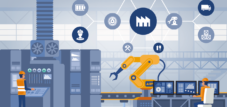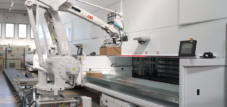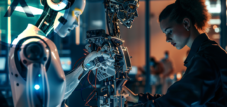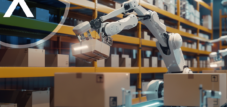Technological advances and their impact: The influence of e-commerce on robotics - automation as the key to success
Language selection 📢
Published on: October 2, 2024 / Update from: October 2, 2024 - Author: Konrad Wolfenstein
🔧🛒 E-commerce and robots: How online retail is driving robotics
📈 The robotics market has witnessed significant growth in recent years attributed to various market drivers. In particular, the growth of the e-commerce sector, economic cycles and the development of the gross domestic product (GDP) have contributed significantly to the expansion and innovation in the robotics industry. This article explains in more detail how these drivers influence the market and what trends and perspectives arise from them.
🛍️ E-commerce as a catalyst for robotics
The e-commerce sector has become a key driver of automation in recent years, particularly in the logistics and fulfillment industries. Since the COVID-19 pandemic, e-commerce has experienced a surge as more consumers shop online and companies expand their digital capabilities. The demand for robots for material handling, storage, packaging and sorting has increased exponentially.
Automation in fulfillment centers has not only increased efficiency but also helped reduce labor costs and minimize error rates. Robots such as autonomous mobile robots (AMRs) and collaborative robots (“cobots”) assist with picking and packing, helping to meet the ever-shorter delivery times that consumers expect. Studies show that the logistics robot market is expected to reach over $10 billion by 2025.
This development is also reflected in the increasing investments in the robotics industry. Companies like Amazon and Alibaba have invested billions in automation technologies in recent years to streamline their e-commerce operations. Small and medium-sized businesses (SMEs) are also increasingly starting to invest in robotics solutions as the technology becomes more affordable and adaptable.
Another factor driving demand for robots in e-commerce is the increasing personalization of products and services. Customers expect individual solutions and tailor-made products, which further increases the need for flexible and intelligent automation systems. Robots that are able to take on different tasks and adapt to different requirements play a crucial role here.
💹 The impact of the business cycle on the robotics market
The economic cycle is another crucial factor affecting the growth of the robotics market. During periods of economic upswing, companies invest more in innovations and new technologies in order to remain competitive. Start-ups and young companies are particularly active in these phases as they are often more agile and can react more quickly to technological developments. These companies often use cutting-edge technologies, including robotics, to differentiate themselves from established companies and serve niche markets.
Robots have taken on a permanent place in the value chain, particularly in growth industries such as the automotive industry, electronics manufacturing and healthcare. While industrial robots are traditionally used for assembly work in the automotive industry, collaborative robots are now entering production that work hand in hand with human employees. This allows for greater flexibility and efficiency, especially during times of high demand or shortages in labor availability.
During periods of recession, however, companies may reduce their investments in expensive robotic solutions, but they could increasingly focus on cost-effective automation solutions to reduce labor costs and increase efficiency. Technological progress enables companies to implement innovative solutions, even in economically difficult times, which contribute to reducing costs and increasing efficiency in the long term.
📊 GDP growth and the impact on the robotics industry
Another key element for the growth of the robotics industry is the gross domestic product (GDP). Countries with a high GDP tend to be more willing to invest in advanced technologies. This applies to both companies and government funding programs. A thriving economy allows companies to allocate larger budgets for research and development and take advantage of new technologies.
In recent years, many developed countries, as well as emerging markets, have launched programs to promote digitalization and automation in industry. In Europe, for example, the “Industry 4.0” initiative plays an important role, while the USA and China are making significant efforts to maintain their leading position in the field of robotics. China, the world's largest manufacturing country, has invested heavily in automation technologies in recent years to modernize its industrial sector and remain competitive.
The impact of GDP growth on the robotics industry can also be seen in the increasing investments in research and development (R&D) in this area. Companies are increasingly relying on artificial intelligence (AI) and machine learning to make robots even more efficient and autonomous. These advances enable robots to complete complex tasks in real time, significantly expanding their applications in various industries.
At the same time, GDP growth in developing countries has also increased the focus of robotics companies on these markets. Countries such as India and Brazil are currently experiencing significant growth in their manufacturing industries and are beginning to invest more in automation technologies in order not to lose touch with industrialized countries. This offers great opportunities for robotics companies that want to position themselves in these emerging markets.
🚀 Innovations and trends in the robotics industry
Aside from the market drivers, there are numerous technological innovations that are driving the growth of the robotics market. A significant trend is the increasing adoption of artificial intelligence and machine learning in robotics systems. These technologies enable robots to handle complex tasks, from real-time data processing to decision-making and problem-solving.
Another important trend is the development of cobots, i.e. collaborative robots that work closely with human employees. These robots are designed to work safely and efficiently in environments where people and machines interact. Cobots are being used more and more frequently, particularly in the manufacturing industry and e-commerce, as they are flexible, cost-efficient and can be easily integrated into existing work processes.
In addition, the robotics industry is increasingly characterized by the development of autonomous mobile robots (AMRs). These robots are able to move independently in dynamic environments and perform tasks such as transporting goods in warehouses or factories. Companies such as Fetch Robotics and Mobile Industrial Robots (MiR) have made significant progress in this area, offering innovative solutions for the logistics and manufacturing industries.
Last but not least, the miniaturization of robotic systems is becoming increasingly important. Smaller, lighter and more energy-efficient robots open up new applications in industries such as medicine, agriculture and food production. In the future, microrobots could be used in medical diagnostics, for example, to carry out minimally invasive procedures or collect samples.
🔮 Future perspectives and challenges
Despite the enormous potential of the robotics market, there are also challenges that need to be overcome. One of the biggest hurdles is the integration of robots into existing workflows, especially in small and medium-sized companies. While large companies are able to make significant investments in automation, smaller companies are often more reluctant because purchasing and implementing robots can be costly.
Increasing automation also raises social questions, particularly with regard to job losses. While robots can help relieve workers of dangerous or monotonous tasks, there are concerns that they could replace human workers in some areas. It will be crucial that companies and governments find ways to balance automation with job creation and workforce reskilling.
The robotics market faces a bright future driven by technological innovations and increasing demand for automation. E-commerce, economic cycles and GDP growth play a central role, but new technologies such as artificial intelligence and collaborative robots will also shape the market in the coming years. It remains exciting to see how the market will develop and what new opportunities will arise for companies and consumers.
📣 Similar topics
- 🤖 The Growth of the Robot Market: An Analysis
- 🛒 E-commerce as a driver of robotics
- 📉 How economic cycles influence robotics
- 🌍 GDP growth and its impact on the robotics industry
- 🔍 Innovations in the robotics industry
- 🤝 Collaborative Robots: Revolutionizing Workplace Dynamics
- 🚀 Autonomous mobile robots: The future of logistics
- 🏭 Miniaturization of robots and new possible uses
- 📈 Investing in robotics: trends and prospects
- 🧩 Challenges and future perspectives of robotics
#️⃣ Hashtags: #Robotics #ECommerce #Automation #AI #Industry4.0
📌 More about robotics
We are there for you - advice - planning - implementation - project management
☑️ Industry expert, here with his own Xpert.Digital industry hub with over 2,500 specialist articles
I would be happy to serve as your personal advisor.
You can contact me by filling out the contact form below or simply call me on +49 89 89 674 804 (Munich) .
I'm looking forward to our joint project.
Xpert.Digital - Konrad Wolfenstein
Xpert.Digital is a hub for industry with a focus on digitalization, mechanical engineering, logistics/intralogistics and photovoltaics.
With our 360° business development solution, we support well-known companies from new business to after sales.
Market intelligence, smarketing, marketing automation, content development, PR, mail campaigns, personalized social media and lead nurturing are part of our digital tools.
You can find out more at: www.xpert.digital - www.xpert.solar - www.xpert.plus






























